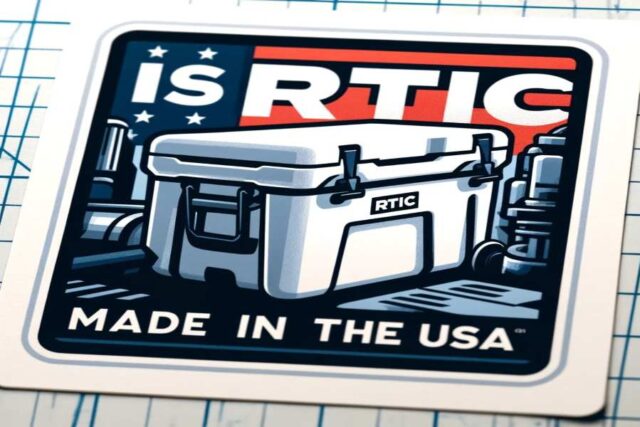In today’s market, discerning consumers are keen to know the origins of their purchases, especially when it involves brands like RTIC, known for its durable outdoor gear. This medium raises the pivotal question: Are RTICs made in the USA? Understanding where and how RTIC products are designed reflects the brand’s commitment to quality and its impact on local economies and sustainability practices.
Exploring the manufacturing roots of RTIC offers insights into the company’s operations and highlights the importance of supporting products that contribute positively to local job markets and environmental standards. This deep dive into RTIC’s production practices enriches our understanding of the actual value embedded in each product.
Is RTIC Made in USA?
No; most RTIC products are not made in the USA but are designed and distributed from their U.S. offices.
RTIC, a famous brand known for its outdoor gear and accessories, primarily manufactures its products in China. Despite being headquartered in the USA, RTIC outsources most of its production to China to keep costs low while maintaining quality. Although not all components are made in the USA, RTIC remains committed to offering its customers durable and competitively priced products.
Why Does The Manufacturing Origin of RTIC Products Matter
Understanding where RTIC manufactures its products is important in shaping consumer perceptions and influencing market dynamics. The manufacturing origin of RTIC products is a pivotal element in their business strategy and consumer relationship.
The location of manufacturing profoundly affects product quality. Regions known for stringent quality control standards ensure that RTIC products uphold high safety and performance criteria. Compliance with these regulations bolsters consumer trust and solidifies RTIC’s reputation for reliability.
Manufacturing decisions reflect a brand’s commitment to ethical practices. By producing in countries with robust labor laws, RTIC ensures the fair treatment of workers, aligning with consumer expectations of ethics. Moreover, local manufacturing stimulates the economy by creating jobs, promoting industry growth, and enhancing the brand’s community impact.
The geographic origin of manufacturing plays a crucial role in a brand’s environmental footprint. Opting for local production minimizes the need for long-distance shipping, significantly reducing carbon emissions. This commitment to sustainability resonates with eco-conscious consumers who value green business practices.
Clear communication about where and how products are made strengthens consumer trust and loyalty. When RTIC openly adheres to high manufacturing standards, consumers are more likely to have a positive view of the brand. Aligning manufacturing practices with consumer values is crucial for maintaining RTIC’s strong market presence and fostering enduring customer relationships.
By emphasizing these factors, RTIC ensures the quality and integrity of its products and deepens its engagement with consumers, meeting their increasing demands for transparency and ethical responsibility.
When Did RTIC Begin Manufacturing in the USA?
RTIC, renowned for its high-quality outdoor gear, has sparked curiosity regarding its manufacturing practices, particularly its production origins in the USA.
Exploring RTIC’s Manufacturing Timeline
RTIC was established in 2015 with a business model emphasizing cost-effectiveness while maintaining high product standards. Initially, the company outsourced the majority of its manufacturing to China. This strategic decision allowed RTIC to compete directly with industry giants by offering comparable products at reduced prices due to lower production costs.
Shifts in Production Practices
Over the years, consumer demand for locally made products has grown, influencing companies like RTIC to reconsider their manufacturing strategies. While RTIC has explored various opportunities for expanding its production in the USA to include some assembly and finishing processes, the bulk of its manufacturing still occurs overseas. Currently, there is no substantial evidence that RTIC has fully transitioned any primary manufacturing operations to the United States.
The Impact Of Manufacturing Decisions
The decision of where RTIC manufactures its products is crucial for customers prioritizing American-made goods. These decisions affect perceptions of quality and impact local economies. Consumers are increasingly looking to support brands that invest in local jobs and manufacturing, supporting the national economy.
RTIC’s manufacturing history in the USA allows consumers to make informed decisions, while production primarily occurs outside the country to maintain competitive costs.
Who Benefits From RTIC’s Manufacturing Decisions?
RTIC’s strategic manufacturing decisions are designed to balance cost, quality, and market competitiveness. While primarily business-oriented, these choices have broader implications, benefiting multiple stakeholders in distinct ways.
Consumers
- Affordable Pricing: By manufacturing primarily in China, RTIC can leverage lower production costs, which translates into more affordable prices for consumers without compromising on quality.
- Wide Product Availability: The cost-effectiveness of RTIC’s manufacturing allows the company to maintain a diverse inventory, ensuring that various products are readily available to meet consumer demand.
- Quality Assurance: Despite the lower costs, RTIC maintains strict quality control measures, ensuring consumers receive durable and reliable products.
Shareholders and Company Executives
- Increased Profit Margins: Lower manufacturing costs contribute directly to higher profit margins, which benefit RTIC’s shareholders and executives.
- Market Expansion: The savings from overseas production enable RTIC to invest in marketing and distribution, expanding its market presence and competitiveness.
- Brand Reputation: By offering quality products at lower prices, RTIC enhances its reputation, attracting a more extensive customer base and potentially increasing shareholder value.
Local Economies in Manufacturing Regions
- Job Creation: RTIC’s manufacturing facilities in China provide numerous jobs, contributing to local employment and economic stability.
- Economic Growth: The operations of large manufacturing plants can lead to local economic growth through various ancillary industries like logistics, packaging, and more.
- Skill Development: Working for an international company like RTIC provides local employees with opportunities for skill development, which can improve their career prospects.
Global Supply Chain Partners
- Business Opportunities: RTIC’s decision to manufacture in China provides significant business opportunities for local suppliers and manufacturers, fostering long-term business relationships.
- Innovation and Collaboration: Suppliers are often required to meet specific standards, which drives innovation and improvements in manufacturing practices.
- Economic Interdependence: These partnerships help create a sense of economic interdependence, leading to more stable economic relations between the involved countries.
RTIC’s manufacturing choices perfectly balance economic strategy and market demands. These decisions benefit shareholders and consumers directly through enhanced affordability and quality. Beyond these immediate effects, they also bolster the economies of manufacturing regions and strengthen global supply chain relations. By making these calculated moves, RTIC secures its growth and plays a significant role in the broader economic landscape.
What Are The Consumers’ Perceptions Of RTIC’s Manufacturing Origin?
Consumer perceptions of RTIC’s manufacturing origin are pivotal in influencing their purchasing decisions and brand loyalty. Expected for its economically priced yet high-quality outdoor gear, RTIC strategically outsources its manufacturing primarily to China. While this decision benefits the company economically, it garners mixed reactions from its customer base.
1. Quality and Affordability Balance:
Many consumers appreciate RTIC’s ability to balance quality and affordability. The general view is that by outsourcing manufacturing, RTIC manages to keep production costs low, allowing the brand to offer lower prices to its customers without significantly compromising on quality. Outdoor enthusiasts often commend the brand for making quality outdoor equipment more accessible to the average consumer. This positive feedback is prevalent in online reviews and product forums, where customers express their satisfaction with the value they receive.
2. Concerns About Manufacturing Ethics and Practices
Conversely, a portion of RTIC’s consumer base expresses skepticism or outright criticism of the brand’s overseas manufacturing strategy. These concerns mainly revolve around the ethical implications of manufacturing in regions with labor standards that differ from those in the United States. Questions about worker welfare and the environmental impact of transporting goods over long distances are expected, potentially undermining the brand’s efforts toward sustainability. Such concerns are particularly vocal among social media users, and groups focused on ethical consumerism.
3. The Demand for American-made products:
A significant consumer segment strongly prefers them, associating them with superior quality and support for the American economy. These consumers are often disappointed to learn that RTIC does not manufacture its products domestically and may choose competitors who align more closely with their preference for locally produced goods. This sentiment influences purchasing decisions and is a recurring theme in community discussions and feedback.
4. The Global Perspective
Globally, perceptions of RTIC’s manufacturing choices vary. International consumers may not prioritize American manufacturing and instead focus more on the quality and price of the products. In these markets, RTIC’s reputation is likely shaped more by the functionality and affordability of its offerings than by the manufacturing location.
5. Impact on Brand Loyalty and Market Expansion
The diverse opinions on RTIC’s manufacturing origins influence brand loyalty and market expansion. Consumers who value transparency and ethical practices might hesitate to endorse or recommend the brand, affecting its reputation and potential for growth in specific demographics. Conversely, those prioritizing cost and quality continue supporting RTIC, aiding its expansion in various consumer segments.
6. Response to Consumer Advocacy
RTIC’s responsiveness to consumer advocacy regarding its manufacturing practices could further shape public perception. If the company increased transparency about its manufacturing processes or took steps towards more sustainable practices, it could sway skeptical consumers and strengthen its brand loyalty across various groups.
Understanding these multifaceted consumer perspectives is crucial for RTIC as it navigates its brand strategy in a competitive global market. Aligning operations more closely with consumer values could enhance RTIC’s market position and deepen customer relationships.
Summary:
Navigating the complexities of global manufacturing, the question “Is RTIC made in the USA?” resonates deeply with consumers focused on quality and ethical production. RTIC’s strategy of manufacturing primarily abroad allows for an appealing mix of affordability and high-quality products. However, this approach also spotlights their commitment to transparency and ethical practices. By actively addressing these concerns, RTIC builds trust and captivates a discerning audience, setting a benchmark in the industry for responsibility and consumer engagement.














